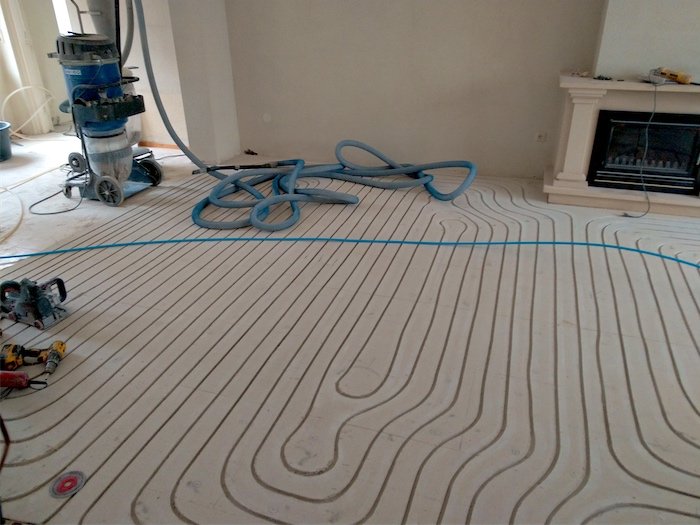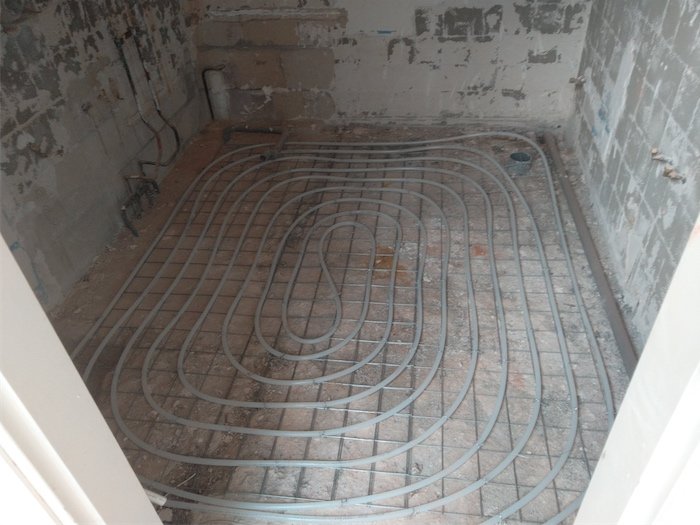Floor heating installation methods
There are many different methods of floor heating installation. In newly constructed buildings floor heating tubing is usually bound to reinforcement steel matts and encased in the screed layer. Floors in renovation projects usually have screed layers already. In this case, the milling of floor heating channels into the floor is a popular and affordable method of installation. If milling isn’t an option, knob-board offers an alternative method.
Types of surfaces suitable for milling
-

Sand/Cement Screed
Sand cement floor is the most common type of sub-floor and is highly suitable for milling floor heating channels. The characteristics of a sand/cement floor can range from extremely porous, soft and crumbly to extremely hard. The quality of the floor needs to be determined before milling. A floor that is too soft may need to be completely removed and replaced. A floor that is too hard could require milling with water to cool the grinding bit. Water milling will add costs.
-

Anhydrite Screed
Anhydrite is a bonded gypsum sand and water compound that is poured as a fluid mortar. An anhydrite sub-floor is approximately 2-5cm thick and can be milled for floor heating tubing. Filling of the milling channels and levelling the floor in preparation for the finished flooring requires specific gypsum compatible products. Standard cement filler will fail to bond. Identifying anhydrite from a sand/cement sub-floor can be difficult. Consult your construction drawings for information on your specific sub-floor.
-

Fermacell sub-floor
Only Femacell type 2E26 boards are used with milling. This board is made from a gypsum product and has a bottom layer of felt and a middle and top layer of Fermacell. The felt layer is mainly for sound insulation but is also a good heat insulator. Fermacell boards offer and option for milling floor heating channels when the floor has restrictive constrains. It is important to note that the boards are glued and screwed during installation. The screws must be removed completely before grinding the floor. Fermacell boards are an option when milling in concrete is not possible. They have a relatively shallow depth and there is no curing time is required. However, Fermacell is more expensive to install than grinding, can sound hollow, and require a solid sub-floor for installation.
-

Tile Floor
Floor heating tubing can be milled into existing floor tile when the tile is in good condition and firmly fixed to the floor. Milling directly into the tile can reduce the labour and cost of installing floor heating. This method works well when the height build-up in the floor is not an issue. Keep in mind that some tile can be very hard and require wet grinding which can add costs.
-

Concrete
Concrete sub-floors are less common than the sand/cement sub-floors but still relatively common. Some houses have the finished flooring installed directly on the concrete. Concrete can be difficult to distinguish from a sand/cement sub-floor. The main difference between the two types of substrate is level of hardness. A regular drill bit can usually drill into a sand/cement floor but will not penetrate a concrete floor.
-

Specialised Equipment
All floor types require an industrial dust or slurry vacuum to contain the waste material from channel grinding. Dry vacuums will capture most of the dust in bags that can be easily disposed of. Harder sub-floors like concrete are much more difficult to mill and require a water cooled grinding bit. Wet milling produces a slurry that must be removed with a specialised industrial slurry vacuum.
-

Thermal EPS Insulation Knob Board
Insulated knob boards are an ideal solution when a floor must be installed quickly or when grinding isn’t and option. The knob board has an insulation layer from 28 or 47mm on the bottom and a plastic pre-formed knob pattern on the top. The heating tubes are secured in a uniform pattern into the pre-formed plastic layer of the board. Once installed the floor is ready for the tubes to be covered in cement.
-

Wire Grid Binding
Very rough and uneven floors can have the floor heating tubing installed by binding the tubes to steel mesh. A sand/cement sub-floor can then be laid overtop encasing the floor heating tubing.

